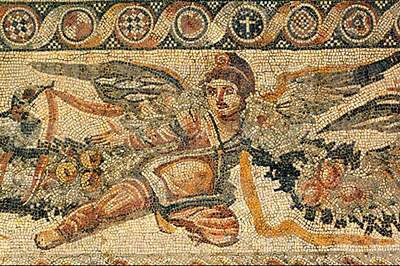The French archeological scientist Moris Sarter has recently given a special lecture on the city’s archeological heritage at- Sweida Educational Theater.
The lecture which was under the title of ”Man and Goddess in Jabil al- Arab at ancient era ” spoke about the important ruins in al- Sweida governorate.
The French scientist asserted in his lecture that al- Sweida city is located on an important ancient archeological city.
” the ruins in al-Sweida governorate are related to three distinguished historical phases :
– the first is from the third millennium to 500 before Christ .
-the second phase is located in the eastern part of the city.
-the third phase which is considered due to the archeological scientists the most important one is after the separation  between Qanawat and Sweida city in the middle of the 2nd century AD,” the researcher said during his lecture.
between Qanawat and Sweida city in the middle of the 2nd century AD,” the researcher said during his lecture.
He also added that Every phase has its ruins and references .The ruins which referred to the 1st phase are the circular city and the ancient wall in addition to the famous citadel in the city Sweida .
The ruins of The 2nd phase are al- Hajj lake and the famous temple Which is located in the city center.
The third phase’s ruins are the big theater and the small hall which included 40 stone seats with Greek numbers in addition to the big church and the arch of the small church which is located near the new highway in the city ”al- Mehwari” .
The lecture also carried a detailed explanation on the importance of the city’s various archeological sites, namely in the country’s villages.
The French scientist also gave priority to the city’s archeological heritage, due to the existence of many texts which referred to the governorate’s key economic and political role in the ancient times.
 ” many men and women from al the European countries came to Sweida at that time to live in it due to its advanced civilized position,” Mr. Moris said, asserting the existence of Greek statements that are related to the middle the 1st century on the city’s ruins in its national museum.
” many men and women from al the European countries came to Sweida at that time to live in it due to its advanced civilized position,” Mr. Moris said, asserting the existence of Greek statements that are related to the middle the 1st century on the city’s ruins in its national museum.
The scientist also asserted the existence of some ruins that are related to the 3rd and 4th century AD with Italian statements on it.
The Italian statements are political letters between the rulers at that time.
At the end of the lecture Mr. Sarter spoke about the distinguished statues of many Goddess in the city, including the statue of the biggist Ba’al Shmil in Cia’a village. He also referred to the Temples of Metra,Athena, the Al-Sharate and Zios in the mountainous village of Ganawate .
He also spoke about the ruins of Cia’a due to its role in revealing the governorate’s vital and political role during the Romanian Empire.
Nahla maaz to Syriatimes – al- Sweida province


 Home
Home